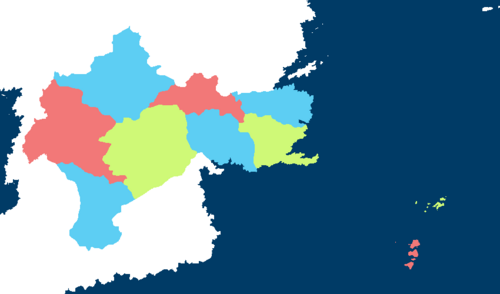Ăpalia
Ăpali Union Kupu Ăpali | |
|---|---|
 Political map of the Ăpali Union | |
| Capital | Isagu |
| Official languages | Ăpali |
| Recognised national languages | Ăpali |
| Recognised regional languages | Anta |
| Ethnic groups | Ăpali, Anta |
| Demonym(s) | Ăpali |
| Government | Federal Republic |
• President | Sohen Hoseci |
| Population | |
• Estimate | 212,850,000 |
• Density | 44/km2 (114.0/sq mi) |
| Currency | Boreal Mark |
| Driving side | right |
History
A Former Colony (1706-1923)
Foundations of a New Land
In the year 1706, a group of intrepid pioneers from the Shasvin Empire set foot on the shores of Cikras, laying the cornerstone for the city of Isagu. Their ambitious spirit drove them to expand further, venturing into the unexplored depths of the continent. By 1707, they had established a firm foothold, gradually pushing through the dense rainforests as they ventured deeper into the heart of this new land.
A Clash of Cultures
As the Shasvin colonists continued their inland expansion, their encounters with the indigenous Anta people took a dramatic turn in 1711. Up until that point, the empire had met little resistance from the native inhabitants. However, as they reached the majestic mountain ranges, they found themselves faced with the unwelcoming Anta. A deep divide emerged, fueled by conflicting desires for control over the land and its valuable resources.
The Anta Conflict and Annexation
Tensions between the Shasvin Empire and the Anta people escalated, culminating in the outbreak of the first Anta conflict in 1815. Despite their technological advantage, the Shasvin forces faced a formidable opponent in the Anta, who possessed an intimate knowledge of the rugged terrain. After years of conflict, the war finally came to an end in 1822, with the Shasvin Empire emerging victorious. The mountainous regions were annexed, firmly establishing Shasvin rule over the Anta people. While the Anta lost their autonomy over the land's resources, their distinctive culture and language were respected and not persecuted.
The Era of Sovereign States (1923-2141)
The collapse of the Shasvin Empire in 1923 marked a turning point in Ăpalia's history. The once-unified colony splintered into various sovereign states that would come to be known as the Ăpali states. The Anta regained the control over their ancestral lands that had been taken from them centuries ago. The term "Ăpali" originated from the phrase "Ă et ep nasali" in the Parkjol Saspí language, which literally translates to "speech with ă." Initially, this phrase was used by the Shasvin Empire to denote the unique dialect spoken in the colony, characterized by the emergence of the vowel ă. However, with the empire gone, the phrase took on a new significance as a symbol of identity.
During the era of sovereign states that spanned the two centuries between the collapse of the Shasvin Empire and the unification of the Ăpali states, various significant events and conflicts shaped the course of Ăpalia's history. These events served as catalysts for the eventual desire for a united nation.
The initial rivalries (1923-1960)
After the fall of the Shasvin Empire, the colony fragmented into multiple sovereign states. Each state, driven by its own interests and ambitions, sought to establish its independence and carve out its own destiny. The initial years were marked by border disputes, territorial conflicts, and power struggles between neighboring states. These conflicts often arose due to resource competition and differing political ideologies. Economic rivalries emerged as states vied for control over trade routes, natural resources, and strategic locations. These rivalries sometimes escalated into localized conflicts and skirmishes.
The Great Eastern Conflict (1975-1992)
The Great Eastern Conflict was a prolonged war between the states of the eastern region of Ăpalia. It was triggered by a dispute over control of key river routes and trade centers. The conflict involved shifting alliances and fierce battles, resulting in significant loss of life and economic instability in the region. The war continued for over a decade before a peace treaty was finally negotiated, leading to a period of relative stability.
The Mountain Wars (2020-2045)
The Mountain Wars were a series of conflicts between several states and the Anta tribes inhabiting the mountainous regions of Ăpalia. The wars were fueled by disputes over land ownership, access to valuable resources, and conflicting cultural interests. Both sides engaged in guerrilla warfare and utilized their respective knowledge of the terrain to their advantage. The protracted nature of the Mountain Wars and the hardships endured by both the states and the Anta tribes highlighted the need for a more cohesive and unified approach to governance and conflict resolution.
The Great Drought and Famine (2058-2094)
The Ăpali states faced a severe drought that lasted several years, leading to widespread crop failures and food shortages across the states. The scarcity of water and agricultural resources resulted in a devastating famine, causing significant suffering and loss of life among the population. The states struggled to provide relief and support to their citizens, exacerbating existing tensions and economic disparities between regions. This crisis highlighted the vulnerability of the states' agricultural systems and the need for stronger collaboration and resource management in the face of environmental challenges. It served as a wake-up call for increased cooperation and economic integration among the states to ensure the well-being and survival of their populations.
The Crisis of Trade (2110-2125)
The Crisis of Trade emerged as a result of increasing tensions and competition among the Ăpali states for trade dominance. Trade disputes and economic protectionism led to a series of trade embargoes and tariffs imposed by different states against each other. This resulted in a decline in overall economic growth and strained inter-state relations. The Crisis of Trade brought to the forefront the need for a unified trade policy and a common platform to address economic issues collectively. These conflicts, among others, gradually revealed the limitations of a fragmented Ăpali landscape. The desire for stability, economic prosperity, and mutual cooperation grew among the states, leading to the emergence of the unification movement in the late 1800s. The experiences of war, territorial disputes, and economic hardships provided the impetus for the Ăpali people to seek a united nation that could effectively address these challenges and forge a brighter future together.

